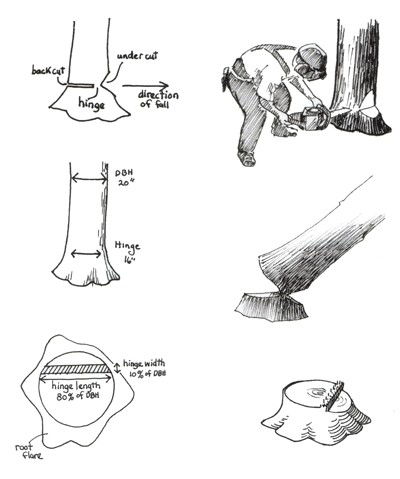Just as a door needs hinges to allow it to function properly, a good hinge is needed to safely bring a tree to the ground. In tree felling, the hinge is the uncut wood left between the notch, known as the undercut, and the back cut. A good hinge will guide the falling tree in the desired direction while holding it to the stump for most of its fall.
Picture a heavy door held by one skinny strap hinge and imagine how easily the door will twist compared to it being held by a wide piano hinge. The same principle applies to tree felling – the longer the hinge, the more control it will have over the tree’s fall. It is recommended that the length of the hinge, measured perpendicular to the direction of fall, be at least 80 percent of the tree’s diameter at breast height (DBH). How deep you go with the undercut will determine the hinge length. Since the tree is roughly circular, the deeper the undercut, the longer the hinge will be. Because trees flare at the base, however, it is not usually necessary to go very deep to get the proper hinge length.
As the tree falls, the wood fibers in the front of the hinge will bend and hold the tree to the stump, while the fibers on the back of the hinge will be the first to pull and break. The hinge should be thick enough so that there is sufficient holding wood, but not so thick that you get large fibers pulling out of the log. The thickness of the hinge (measured along the direction of fall) should be about 10 percent of the DBH. You establish the thickness when making the back cut. Most inexperienced cutters start their back cut at the back edge of the tree and cut toward the hinge. Whatever is left over is the hinge.
Professionals use a bore cut or plunge cut, which will allow you to accurately set the hinge before completing the back cut. Using a bore cut will also allow you to get safely away from the tree before it starts to fall. If you come in from the back of the tree, you may find that the tree starts falling before you have set the hinge, leaving you in a dangerous position if the tree splits or jumps off the stump.
The hinge will break completely when the faces of the undercut close. To ensure that the hinge holds the tree for most of its fall, therefore, the opening of the undercut should be at least 70 degrees. It is important to avoid bypass in the undercut – its upper and lower faces must meet perfectly. If there is bypass, the kerf of the bypass becomes your undercut, and as soon as this closes, the hinge will break and you will lose control of the tree, regardless of the size of the undercut you had planned.
By taking the time to calculate the desired hinge width and thickness, and by developing a good felling plan for each tree, you can improve your tree-felling proficiency and increase your safety at the stump.


